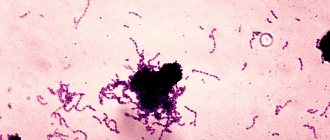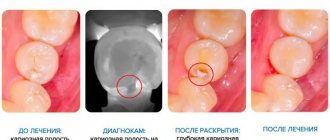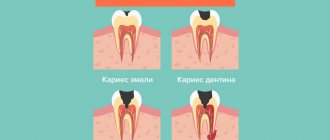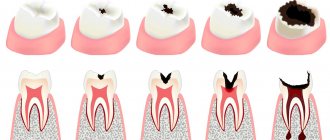Filling is a complex of dental procedures, including the removal of tooth tissue destroyed by caries, disinfection and treatment of the resulting cavity with adhesive preparations, placement and grinding of a dental filling.
Normally, after performing the above procedures, the patient should not experience discomfort or pain. For this reason, the appearance of any unpleasant sensations in the area of a filled tooth is an absolute reason for a return visit to the dental office.
Causes of tooth pain after filling
Pulpitis
The appearance of acute, spontaneous pain that grows and intensifies at night in a filled tooth may be due to the development of chronic or acute pulpitis. If such symptoms are detected, it is necessary to contact a dentist as soon as possible to remove a previously placed filling, remove the inflamed pulp, fill the root canals and the carious cavity itself.
Development of secondary caries
The source of pain in the tooth after filling can also be secondary caries, which gradually develops under the filling. The most common causes of this pathology are:
Causes of secondary caries
- insufficient disinfection of the carious surface before placing a filling;
- displacement of the installed filling under the influence of external factors;
- shrinkage of the filling material, which contributes to the formation of gaps between the filling and dental tissues;
- injury resulting in damage to the filling;
- irregular oral hygiene;
- violation of filling technology.
Treatment of secondary caries
When a secondary caries process is detected, the dentist removes the previously placed filling, cleans the resulting cavity from destroyed tissue, disinfects it and re-fills the tooth.
Underdrying or overdrying of the cavity
The causes of spontaneous pain that increases with biting in a treated tooth may be under-drying or over-drying of the tissues before filling. Before applying adhesive preparations, the surface dental tissues must be dried to a “wet sand” state (that is, the surface must remain wet, but there cannot be drops of water on it).
Consequences of overdrying tissues
Overdrying of dental tissues leads to damage to the nerve endings located in the surface layers of dentin. In turn, the death of nerve fibers can cause inflammatory damage to the pulp and other serious complications. Mild pain caused by overdrying of the carious cavity most often goes away on its own within 5-13 days. In situations where pain intensifies or persists for two weeks, patients are advised to return to the dental clinic for help.
Consequences of not drying the cavity
Failure to dry out the treated carious cavity can also cause pain. Drops of moisture prevent the penetration of adhesive preparations into the dentinal tubules, therefore, when the filling material shrinks, the composite easily comes off from the cavity floor, thereby forming pathological sinuses in the dental tissues. The only way out of this situation can be to replace the previously installed filling.
Granuloma or dental cyst
One of the likely causes of tooth pain after filling may be the formation of a granuloma (a localized area of inflamed tissue) or a root cyst (a pathological cavity in the gum tissue filled with bacteria, dead cells, blood and other physiological fluids). Granulomas and cysts are treated both conservatively (for example, using the depophoresis method) and through surgical intervention (cystectomy, hemisection, etc.).
Allergic reaction
In some cases, pain in a filled tooth can be the result of an allergic reaction to the components of the filling material. The clinical picture may be supplemented by urticaria, the appearance of an itchy rash and swelling on the patient’s skin and mucous membranes. If a patient is diagnosed with an allergy to the material used, the filling is immediately replaced.
What are the consequences of improper treatment of caries?
Dentist-therapist Olga Vitalievna Panova tells
Caries treatment is often not taken seriously. This is not responsible jewelry work in the canals, where unnecessary movement can lead to tooth loss. Fillings seem like something simple that you can save money on without thinking about quality. I'll tell you why this approach is dangerous.
Outdated materials
Fillings made of cement, chemically cured fillings, or low-quality photopolymer composites will not last long. Ask your doctor about the guarantee: its absence should be cause for concern. Ask your doctor about the brand and country of origin of the filling material. You can google the name and read about the benefits, make sure that the material is offered by many major suppliers.
Filling made from cheap materials:
- Sooner it will require replacement and new treatment costs.
- Doesn't fit tightly. Caries forms under the filling, which is difficult to notice. Caries will spread deeper, turning into pulpitis. It also often causes bad breath.
- It is striking due to the poor palette of shades and levels of transparency.
Low-quality materials cannot make a beautiful, inconspicuous restoration. But if a doctor recommends replacing an old cement filling, then the reason is often the health of the tooth rather than aesthetics.
Prevention of caries
In the photo, dentist Olga Vitalievna Panova performs fluoride prophylaxis
Photopolymerization
the dentist illuminates the filling in parts to make it more reliable and less noticeable
Incorrect installation
It is important not only what to fill a tooth with, but also how to do it. The reliability of treatment depends on the qualifications of the doctor, his knowledge of modern technologies and work experience. No less important is the equipment of the clinic and the availability of precise instruments.
Consequences of unsuccessful installation:
- Loose fit, caries under the filling. In a good clinic, this is prevented by the careful work of the doctor; in some cases, a rubber dam will be required to isolate from saliva.
- Incomplete removal of infected tooth tissues, development of secondary caries. To avoid this, you need to supplement the vigilance of the human eye with reliable caries markers - chemicals that will color the damaged tissues with a bright color.
- Or, on the contrary, excessive removal of tooth tissue: because of this, the tooth will withstand less treatment. To clearly see the boundary between healthy and diseased dentin at the time of drilling, you need a trained eye and the right lighting. A turbine tip with fiber optics, which illuminates the tooth right at the treatment site, is very helpful.
- Fragility of the filling due to overheating/underheating of the photopolymer material. To keep the price low, a doctor needs to see many patients per day. It is tempting to speed up the process by polymerizing the filling in one step instead of layer-by-layer application.
- Discomfort: rough filling, sharp edge, uncomfortable teeth closure. It is important that the doctor takes his time and devotes sufficient time to the final stages.
- Bite removal. If the doctor does not know how to restore the anatomical shape of the tooth with a filling and shape it to suit the bite, then he simply cuts off half of the filling so that it does not interfere with the patient. The tooth ceases to fully participate in chewing, and the load on neighboring teeth increases.
How to protect yourself from improper treatment?
You yourself know how to choose a clinic in the Internet era. Pay attention to reviews, awards, age of dentistry, information about equipment, etc.
But a clinic is more a matter of convenience, service, and proximity to home. A doctor will treat you.
Before starting treatment, consult a dentist. Get to know each other, ask all the necessary questions. What materials are used, what experience does the doctor have, what guarantees. Look at doctor's diplomas from master classes and courses, ask to see examples of restorations.
Invest time in health
You may think this is too long. A lot of fuss because of a small hole in the tooth. But once you have done all this work, you will find your doctor, whom you will trust with your dental health. Choose a dentist responsibly once, and your teeth will be in good hands for many years.
I wish you good health and good mood. Sincerely, dentist-therapist Olga Vitalievna Panova.
Recommendations for eliminating the causes of pain in a filled tooth
If you experience discomfort or pain in a filled tooth, it is recommended:
- eliminate the load on the diseased tooth;
- seek professional dental care immediately;
- stop using traditional medicine.
Procedures related to filling replacement, removal of granulomas and cysts are performed on an outpatient basis and do not require much time.
At the same time, timely seeking dental care at a 24-hour dentistry allows you not only to get rid of unpleasant symptoms in the shortest possible time, but also to prevent the development of serious complications.
What are the causes of pathology
In accordance with generally accepted sanitary standards, the maximum concentration of fluorine compounds in water should not exceed 1.5 mg/l. But it should be remembered that fluoride also enters the body during breathing and through food. An excess of this microelement negatively affects tooth enamel and begins to destroy it. If you do not consult a doctor in time, bone tissue pathologies may develop - osteoporosis or osteosclerosis.
Important! The occurrence of the disease is associated with the individual characteristics of the body. Sometimes fluorosis develops at lower concentrations of fluoride.
Mainly permanent teeth are affected, in rare cases – milk teeth in children. This is due to the fact that the mineralization of the baby’s first teeth begins and ends during the period of intrauterine development. At this time, the placenta protects the child’s body from an excess of fluoride. But if a pregnant woman lives in an area where the content of fluoride compounds in the water greatly exceeds the norm, then the disease can also affect the child’s baby teeth.
Children aged 3–4 years are at risk if they have consumed water with a high content of fluoride compounds for 3 or more years. This disease is also diagnosed in adults who work in industries with high levels of fluoride in the air.
Prevention of purulent pulpitis
Purulent pulpitis is a rather insidious disease that can develop at any time and in almost every patient. To avoid its occurrence, you need to strictly monitor your oral hygiene, promptly consult a doctor and treat caries and other dental diseases.
It is necessary to visit a specialist even if the slightest symptoms appear in the form of a reaction to cold and hot, pain when biting or pulsation in the tooth.
It is also important to contact only qualified doctors who can provide a high-quality and professional filling. Remember: the better the filling, the longer the tooth will remain healthy.
We hope that the problem of pulpitis will never affect you, and all visits to dentists will be exclusively preventive. Professional toothpaste “ASEPTA PLUS REMINERALIZATION” will help strengthen your teeth and prevent the occurrence of caries and pulpitis.
This product increases the resistance of teeth to the formation of caries; high concentrations of hydroxyapatite and thermal mud help strengthen teeth and gums and reduce hypersensitivity.
How to remove white spots on teeth?
It is impossible to treat the manifestations of a disease well without knowing what exactly causes them. Methods for dealing with stains directly depend on the cause that caused them:
- If you have fluorosis, you will need to change your drinking water, exclude fluoride-containing foods (legumes, sea fish, spinach) from your menu, and select hygiene products that do not contain this element. This will help prevent further destruction of the enamel, but aesthetic restoration will help cope with the existing one.
- In case of hypoplasia, it will be necessary not only to correct the diet, but also to coat the teeth with special remineralizing and protective compounds. In particularly difficult situations, restoration of damaged enamel cannot be avoided.
- In case of caries, remineralization is carried out; according to indications, removal of the infected area of enamel and microfilling are performed. Treatment of caries in the white spot stage is the simplest, easiest and most comfortable for the patient, so it is very advisable to contact a dentist at this stage.
As Svetlana Leonidovna Kuzmina, a dentist at the 32 Dent clinic, notes, “if you notice a white spot on your teeth that does not disappear for several days, it is better to immediately consult a specialist in order to promptly identify and eliminate the cause that caused the pathology, “Only a dentist can make an accurate diagnosis and prescribe adequate treatment.”










